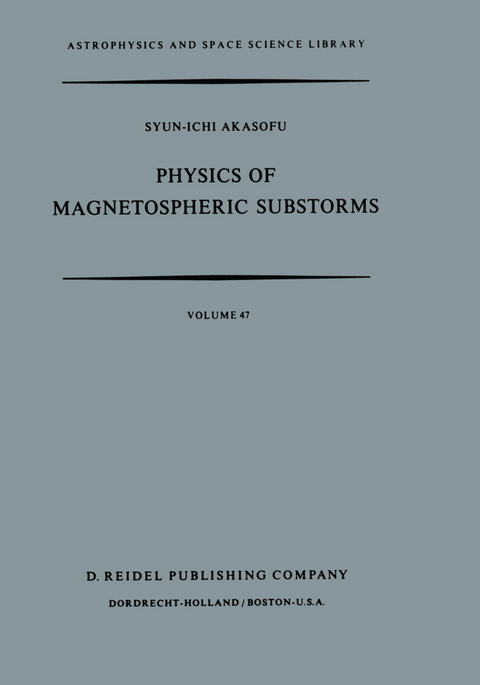
Physics of Magnetospheric Substorms
Kluwer Academic Publishers (Verlag)
978-90-277-0748-2 (ISBN)
- Titel z.Zt. nicht lieferbar
- Versandkostenfrei innerhalb Deutschlands
- Auch auf Rechnung
- Verfügbarkeit in der Filiale vor Ort prüfen
- Artikel merken
1 Open Magnetosphere and the Auroral Oval.- 1.1. Open Magnetosphere.- 1.2. Auroral Oval.- 1.3. Open Magnetosphere and the Auroral Oval.- 1.4. Solar Wind — Magnetosphere Dynamo.- References.- 2 Auroras and Auroral Particles.- 2.1. Introduction.- 2.2. Auroras in Different Local Time Sectors.- 2.3. Auroral Electrons: The Statistical Precipitation Pattern.- 2.4. Auroral Electrons: Spectra of Auroral Electrons.- 2.5. Auroral Electrons and Field-Aligned Currents.- 2.6. Auroral Particles and Atmospheric Emissions.- 2.7. Auroral Protons.- 2.8. Auroral Helium Ions (He++, He+) and Oxygen Ions (O+).- 2.9. Auroral Oval and the Polar Ionosphere.- 2.10. Summary.- References.- 3 Distribution of Plasmas in the Magnetosphere.- 3.1. Five Plasma Domains.- 3.2. Plasma Mantle.- 3.3. Polar Cusp.- 3.4. Plasma Sheet.- 3.5. Origin and Dynamics of the Sheet Plasma.- 3.6. Van Allen Belts.- 3.7. Plasmasphere.- 3.8. Magnetospheric Plasmas and Auroral Particles.- 3.9. Acceleration Processes of Arc-Producing Auroral Electrons.- References.- 4 Responses of the Magnetosphere to Interplanetary Disturbances.- 4.1. Interplanetary Disturbances.- 4.2. Interplanetary Pressure Disturbances and Magnetospheric Responses.- 4.3. Changes of the IMF EW Component and Magnetospheric Responses.- 4.4. Changes of the IMF NS Component and Magnetospheric Responses.- References.- 5 Magnetospheric Substorms: Introduction.- 5.1. A New Classification of Magnetospheric Disturbances.- 5.2. Substorm Energy ?? and Substorm Function ? = ?(?D).- 5.3. Substorm Intensity.- 5.4. Time-Dependent Merging.- 5.5. Magnetospheric Substorms.- 5.6. Geomagnetic and Magnetospheric Storms.- References.- 6 Magnetotail Phenomena During Magnetospheric Substorms.- 6.1. Introduction.- 6.2. B Vector Dipping.- 6.3. Plasma Sheet Thinning.- 6.4.Magnetotail Field BT and Radius RT.- 6.5. Auroral Bulge.- 6.6. Plasma Sheet Expansion.- 6.7. Plasma Flow.- 6.8. Other Important Magnetotail Phenomena.- References.- 7 Magnetospheric Currents During Substorms.- 7.1. Introduction.- 7.2. Field-Aligned Currents.- 7.3. Field-Aligned Currents and the Auroral Electrojets.- 7.4. Auroral Electrojets.- 7.5. Cross-Section of the Electrojets.- 7.6. Latitudinal Cross-Section of the Auroral Electrojet and its Relation to the Interplanetary Magnetic Field Polarity.- 7.7. Ionospheric Currents and Electric Fields.- 7.8. Thermospheric and Ionospheric Disturbances.- References.- 8 Penetrating Convection Electric Field, Plasma Injection and Plasmasphere Disturbances.- 8.1. Introduction.- 8.2. Penetration of the Convection Electric Field into the Inner Magnetosphere and the Resulting Plasma Injection.- 8.3. Relationship between Particles at the Geosynchronous Distance and Auroral Activity near the Geomagnetically Conjugate Point.- 8.4. ‘The Fault Line’.- 8.5. Drift Motions.- 8.6. Deformation of the Plasmasphere and Associated Ionospheric Disturbances.- References.- 9 Solar-Terrestrial Relations and Magnetospheric Substorms.- 9.1. Interplanetary Disturbances.- 9.2. Morphological Model of Magnetospheric Substorms.- 9.3. Concluding Remarks.- References.- Index of Names.- Index of Subjects.
| Erscheint lt. Verlag | 28.2.1977 |
|---|---|
| Reihe/Serie | Astrophysics and Space Science Library ; 47 |
| Zusatzinfo | 617 p. |
| Verlagsort | Dordrecht |
| Sprache | englisch |
| Themenwelt | Naturwissenschaften ► Physik / Astronomie ► Astronomie / Astrophysik |
| ISBN-10 | 90-277-0748-0 / 9027707480 |
| ISBN-13 | 978-90-277-0748-2 / 9789027707482 |
| Zustand | Neuware |
| Haben Sie eine Frage zum Produkt? |
aus dem Bereich


